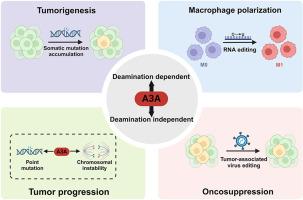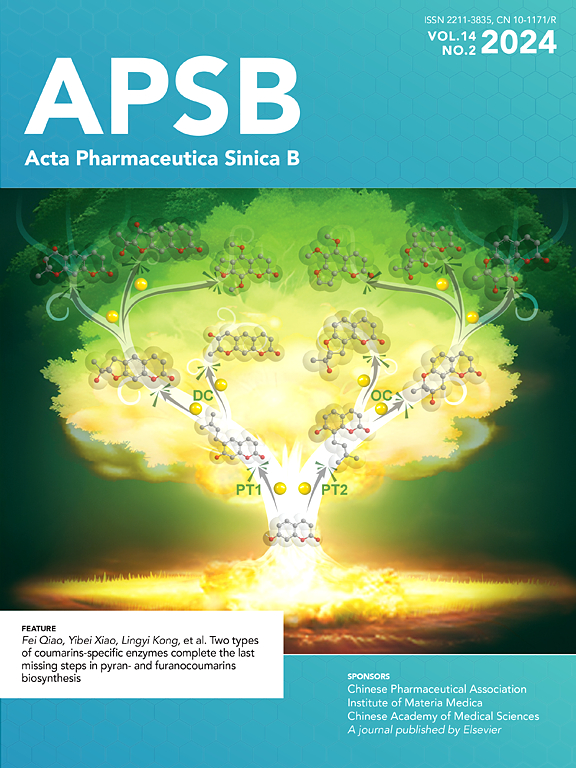概述 APOBEC3A 在肿瘤发生中的功能和机制
IF 14.7
1区 医学
Q1 PHARMACOLOGY & PHARMACY
引用次数: 0
摘要
APOBEC3(A3)家族通过DNA/RNA单链脱氨在免疫系统中发挥着关键作用。癌症大多源于体细胞中慢性突变的积累,而最近的研究突出表明,A3 家族是导致肿瘤相关突变的主要因素,其中 A3A 是导致癌症相关突变的关键驱动基因。A3A 通过编辑入侵宿主的癌症相关病毒的基因组,帮助宿主抵御病毒诱发的肿瘤。然而,当它异常表达时,就会导致基因组发生持续、慢性突变,从而助长肿瘤的发生。值得注意的是,A3A 在先天性免疫细胞(尤其是巨噬细胞)中有显著表达,从而影响肿瘤浸润免疫细胞的功能状态和肿瘤生长。此外,A3A 在肿瘤细胞中的表达可能会直接影响其增殖和迁移。越来越多的研究发现,A3A 与多种癌症密切相关,这表明 A3A 在癌症治疗中具有潜在意义。本文主要根据潜在机制对 A3A 与肿瘤发生关系的证据进行分类和总结,旨在为进一步研究 A3A 的功能及其在癌症治疗领域的发展提供有价值的参考。本文章由计算机程序翻译,如有差异,请以英文原文为准。

An overview of the functions and mechanisms of APOBEC3A in tumorigenesis
The APOBEC3 (A3) family plays a pivotal role in the immune system by performing DNA/RNA single-strand deamination. Cancers mostly arise from the accumulation of chronic mutations in somatic cells, and recent research has highlighted the A3 family as a major contributor to tumor-associated mutations, with A3A being a key driver gene leading to cancer-related mutations. A3A helps to defend the host against virus-induced tumors by editing the genome of cancer-associated viruses that invade the host. However, when it is abnormally expressed, it leads to persistent, chronic mutations in the genome, thereby fueling tumorigenesis. Notably, A3A is prominently expressed in innate immune cells, particularly macrophages, thereby affecting the functional state of tumor-infiltrating immune cells and tumor growth. Furthermore, the expression of A3A in tumor cells may directly affect their proliferation and migration. A growing body of research has unveiled that A3A is closely related to various cancers, which signifies the potential significance of A3A in cancer therapy. This paper mainly classifies and summarizes the evidence of the relationship between A3A and tumorigenesis based on the potential mechanisms, aiming to provide valuable references for further research on the functions of A3A and its development in the area of cancer therapy.
求助全文
通过发布文献求助,成功后即可免费获取论文全文。
去求助
来源期刊

Acta Pharmaceutica Sinica. B
Pharmacology, Toxicology and Pharmaceutics-General Pharmacology, Toxicology and Pharmaceutics
CiteScore
22.40
自引率
5.50%
发文量
1051
审稿时长
19 weeks
期刊介绍:
The Journal of the Institute of Materia Medica, Chinese Academy of Medical Sciences, and the Chinese Pharmaceutical Association oversees the peer review process for Acta Pharmaceutica Sinica. B (APSB).
Published monthly in English, APSB is dedicated to disseminating significant original research articles, rapid communications, and high-quality reviews that highlight recent advances across various pharmaceutical sciences domains. These encompass pharmacology, pharmaceutics, medicinal chemistry, natural products, pharmacognosy, pharmaceutical analysis, and pharmacokinetics.
A part of the Acta Pharmaceutica Sinica series, established in 1953 and indexed in prominent databases like Chemical Abstracts, Index Medicus, SciFinder Scholar, Biological Abstracts, International Pharmaceutical Abstracts, Cambridge Scientific Abstracts, and Current Bibliography on Science and Technology, APSB is sponsored by the Institute of Materia Medica, Chinese Academy of Medical Sciences, and the Chinese Pharmaceutical Association. Its production and hosting are facilitated by Elsevier B.V. This collaborative effort ensures APSB's commitment to delivering valuable contributions to the pharmaceutical sciences community.
 求助内容:
求助内容: 应助结果提醒方式:
应助结果提醒方式:


